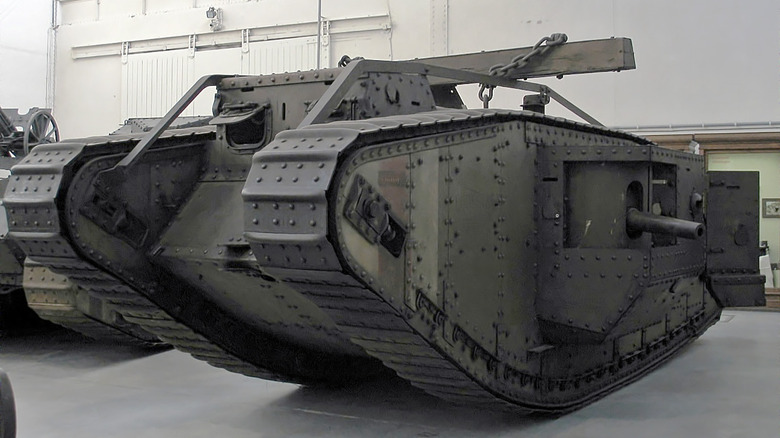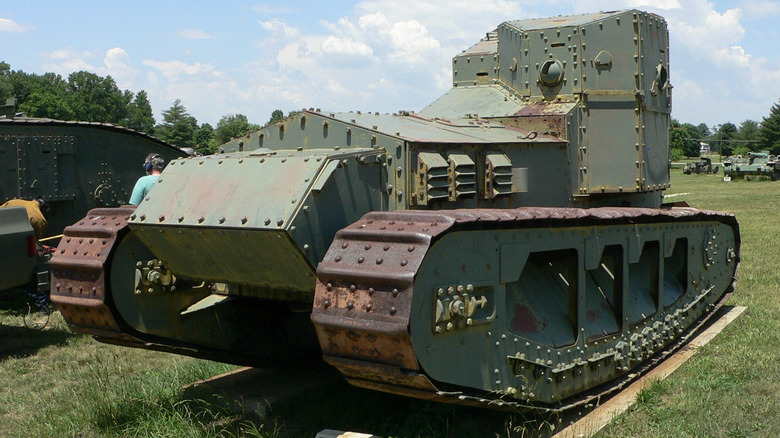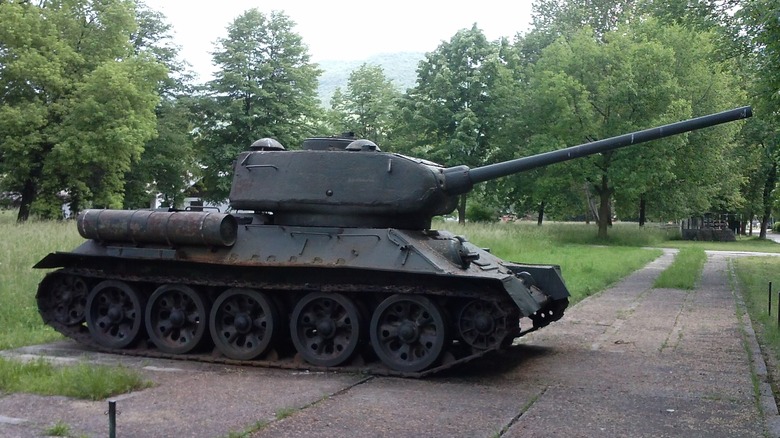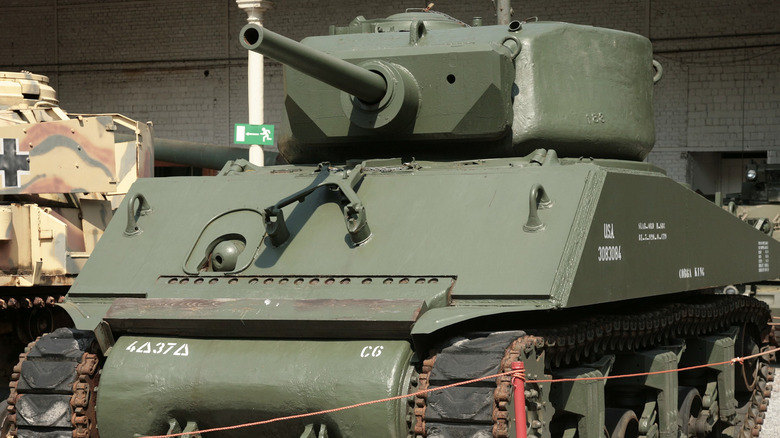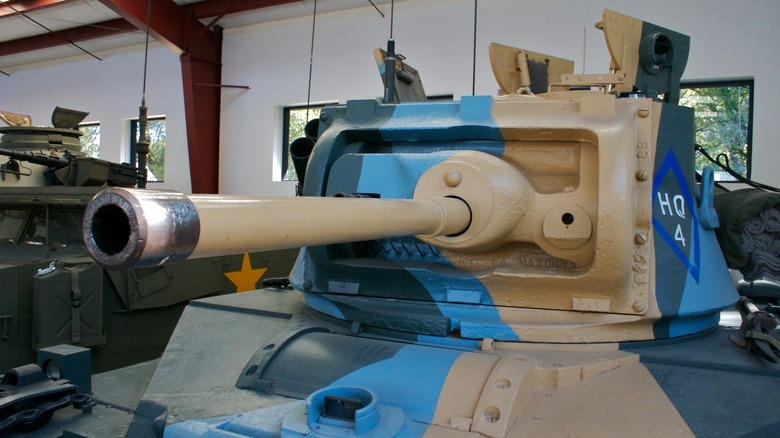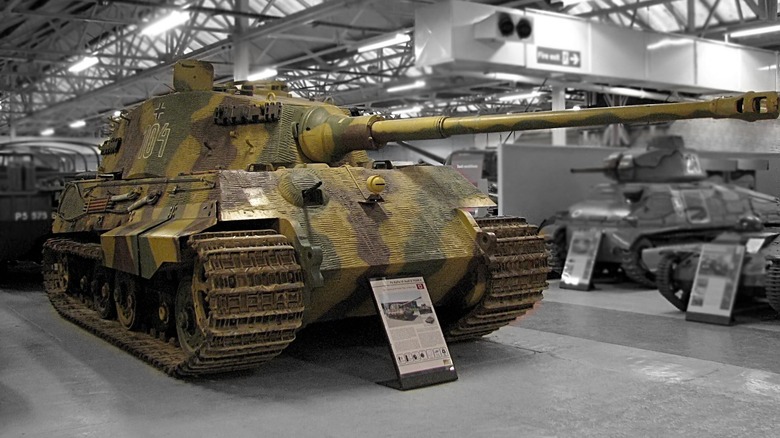The Major Differences Between WW1 And WW2 Tanks
Tanks used in the Second World War evolved significantly compared to the Great War, going from slow, cumbersome armored pieces of rolling artillery whose effectiveness in many situations was questionable to machines with enough firepower and mobility to change the course of a battle. The basic principles of what a tank was remained the same between the two wars, but by the time World War II broke out, major advances in armor, turret technology, and propulsion made tanks much more effective and versatile.
The idea of the tank can be traced back centuries. One of the most famous early tank designs is Leonardo da Vinci's armored car, penned in the 15th century. It was a conical vehicle envisioned to be made out of thick wood, with guns sticking out in every direction, similar to what you would see on a period warship, but it didn't have a turret.
This seems to have loosely served as the inspiration for the first tanks that served in World War I since they too lacked the big rotating top turret. Many early WWI tanks had their turrets mounted on the side of the vehicle, much like da Vinci's original design, although this approach was gradually dropped in favor of the layout we today associate with tanks.
[Featured image by Paul Hermans via Wikimedia Commons | Cropped and scaled | CC BY 3.0]
World War I Tanks Were Slow and Cumbersome
The Mark I British Army heavy tank that entered service in 1916 was agonizingly slow to move, crawling along at a maximum speed of 3.7 mph (6 km/h), so it could easily be outrun and outmaneuvered by infantry or even the cavalry unit that some armies still used in WWI. It was powered by a 16-liter inline-six engine that had an output of just 105 horsepower, which wasn't really enough to motivate this over-27-ton vehicle to do anything other than crawl.
By the end of World War I, the same design had evolved, and it was called the Mark V. It got a new and larger 19-liter six-cylinder engine that made 150 horsepower, allowing it to increase its maximum speed to 5 mph (8 km/h), and its operational range increased from under 24 miles to 45 miles, or around 10 hours of endurance versus just 6.2 hours in the Mark I.
There were lighter and quicker tanks operating in WWI, like the British-designed Medium Mark A Whippet (pictured), a 14-ton medium tank that used two four-cylinder 45-horsepower engines to achieve a top speed of 8.33 mph (13.4 km/h). The Whippet was one of the war's quickest and most agile tanks, although drivers also found it difficult to manage its two engines, so even though it could turn more sharply than many other tanks of the day, its usability was hampered by its twin-engine design.
[Featured image by Mark Pellegrini via Wikimedia Commons | Cropped and scaled | CC BY 2.5]
Tanks Became More Versatile in World War II
As the start of World War II loomed, Germany was confident that it could take on any army with its new tanks that not only had firepower, speed, and maneuverability on their side but were also more dependable than the vast majority of World War I designs. One of the fastest early WWII tanks was the Panzer II, which entered service in 1936 and had a top speed of just under 25 mph (40 km/h).
It wasn't extremely powerful, featuring a single Maybach six-cylinder gasoline engine with around 140 horsepower. However, with advancements in armor and building methods, engineers were able to make it considerably lighter than a WWI tank of its size. It weighed around 9 tons, and this also made it considerably better on fuel, with an operational range of almost 120 miles (190 km) on a single tank of gasoline.
However, even though Germany is credited with having the most advanced tanks in World War II, it was Russia that made the ones with the highest top speeds. The T-34 (pictured), regarded as one of the overall best and most influential tanks of the war, is also the fastest tank of WWII, with a top speed of between 31 and 34 mph (50 to 55 km/h).
[Featured image by BiH via Wikimedia Commons | Cropped and scaled | CC BY 3.0]
Tank Armor Became Lighter and More Effective in World War II
Sloped armor is probably one of the biggest advancements in tank armor since these vehicles were first introduced. Interestingly, Leonardo DaVinci designed his armored car with a sloped design, although this did not inspire the shape of the first tanks, which could best be described as rolling metal boxes.
With sloped armor, engineers were able to reduce the armor's thickness and, therefore, the vehicle's weight. Between the implementation of sloped armor, the increase in the quality of steel used in its construction, and the use of composite armor that featured layers of different materials to improve resistance to projectile penetration, tanks got lighter. That brought all the associated benefits of speed, acceleration, agility, and range.
Modular armor was also introduced in World War II. It allowed additional armor plating to be added to certain models of tanks when the battlefield required more protection from projectiles, or it could be removed depending on the threat level. If a tank got hit, modular armor could also easily be removed and replaced, allowing vehicles to return to battle quickly.
Top-Mounted 360-Degree Turrets Changed the Game
Even though there were tanks with rotating top-mounted turrets made as early as 1917 (such as France's Renault FT), the configuration didn't become the norm until the interwar period. Models like the American M4 Sherman and the Russian T-34 were among the earliest tanks with top-mounted (and fully enclosed) turrets that could move 360 degrees, and both were highly acclaimed for their capability and versatility.
It didn't matter what main gun a tank was carrying; the fact that it could not only be aimed up and down but also left and right gave the vehicle a clear advantage. Unlike older tanks that had to physically rotate, newer models could simply rotate their turret to follow a target.
Acquiring and engaging targets was much quicker too, and this made tanks useful in a wider variety of roles and tactical scenarios on the battlefield. They could, for instance, be effectively used in flanking maneuvers, more quickly adapt to changing conditions, and be more apt at taking enemy positions by surprise and off-guard.
Another significant advantage came courtesy of the turret's placement on the top of the vehicle. This enabled operators to position the vehicle advantageously in relation to the terrain, walls, or building ruins, hiding most of its body and exposing only the turret. In a situation like this, most of the tank would be protected while being able to engage enemies.
[Featured Image by Sean O'Flaherty via Wikimedia Commons | Cropped and scaled | CC BY 3.0]
Guns Got Bigger and Better in World War II
The largest-caliber guns on World War I tanks weren't much bigger than 50 mm, but by the end of World War II, they had exceeded the 100 mm mark. Some of the biggest guns fitted to a WWII tank include the 88 mm of Germany's Tiger tank, which had a range of around 1.2 miles (2 kilometers), and it could fire standard antitank ammunition, armor-piercing rounds, or high-explosive rounds, with the latter making it effective against light vehicles and infantry.
An even bigger 122 mm gun was placed atop the Russian IS-2 heavy tank, a huge 46-ton colossus that was one of the few enemy tanks to pose a threat to the aforementioned Tiger tanks. In testing, this gun was found to be able to penetrate a Tiger's thick frontal armor from a distance of 1.5 miles (2.5 kilometers), which meant even the heaviest of armored vehicles stood little chance against a direct hit from an IS-2.
[Featured Image by Hohum via Wikimedia Commons | Cropped and scaled | CC BY 3.0]
